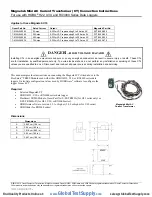
44
45
Signal and sensor error info via display front 4501
Sensor error (see limits in the table) is displayed as SE.BR (sensor break) or
SE.SH (sensor short). Signals outside the selected range (not sensor error,
see table for limits) are displayed as IN.LO indicating low input signal or
IN.HI indicating high input signal. The error indication is displayed in line 3
as text and at the same time the backlight flashes. Line 4 of the display is a
status line which displays status of relay 1 and relay 2, COM (flashing bullet)
indicating correct functioning of 4501 and arrow up/down which indicates
tendency readout of the input signal. If the figure 1 or figure 2 flashes, the
unit has detected that the setpoint has been exceeded and that the relay is in
“delay” mode. When the delay time has passed and the relay makes/breakes,
the relay sign either displays or disappears.
Signal and sensor error indication without display front
Status of the unit can also be read from the red/green LED in the front of the module.
Green flashing LED 13 Hz indicates normal operation.
Green flashing LED 1 Hz indicates sensor error.
Steady green LED indicates internal error.
Steady red LED indicates fatal error.
Relay functions
5 different settings of relay function can be selected.
Setpoint:
The unit works as a single trip amplifier
Window:
The relay has a window that is defined by a low and a high
setpoint. On both sides of the window the relay has the
same
status.
Error function:
The relay is activated by sensor error.
Power:
The relay is activated as long as the power is on.
Off:
The relay is deactivated.
I
ncreasing/decreasing:
The relays can be set to activate at increasing or
decreasing input signal.
Delay:
An ON and an OFF delay can be set on both relays in the range
0...3600 s.
Hysteresis:
A hysteresis can be set at 0.1...25% of the span or between 1 and
2999 counts.
Advanced functions
The unit gives access to a number of advanced functions which can be reached
by answering “Yes” to the point “adv.set”.
Display setup:
Here you can adjust the brightness contrast and the backlight.
Setup of TAG numbers with 6 alphanumerics. Selection of functional readout
in line 3 of the display - choose between readout of analogue output or tag no.
Two-point process calibration:
The unit can be process-calibrated in 2 points
to fit a given input signal . A low input signal (not necessarily 0%) is applied
and the actual value is entered. Then a high signal (not necessarily 100%) is
applied and the actual value is entered. If you accept to use the calibration,
the unit will work according to this new adjustment. If you later reject this
menu point or choose another type of input signal the unit will return to
factory calibration.
Process simulation function:
If you agree to the point “EN.SIM” it is possible
to simulate an input signal by means of the arrow keys and thus control the
output signal up or down. When you finalise the point with
, the unit returns
to normal mode. The following point allows you to activate relay 1 and relay
2 by means of the arrow-keys up/down. You must exit the menu by pressing
(no time-out).
Password:
Here you can choose a password between 0000 and 9999 in order
to protect the unit against unauthorised modifications to the configuration.
The unit is delivered default without password. If you have locked the unit
with a password by mistake, you can always open the menu by using the
master password 2008.
Language:
In the menu ”lang.setup” you can choose between 7 different
language versions of help texts that will appear in the menu. You can choose
between UK, DE, FR, IT, ES, SE and DK.
Auto diagnosis
The unit performs an advanced auto diagnosis of the internal circuits.
The following possible errors can by displayed in the front unit 4501.
CJ.ER - CJC sensor defect or CJC temperature outside range
FL.ER - Flash error
AO.ER - No load on the current output (only for 4...20 mA)
NO.CO - Connection error
IN.ER - Error levels on input
TY.ER - Configuration in 4501 does not match this product type
Selection of units
After choosing the input signal type you can choose which process units should
be displayed in text line 2 (see table). By selection of temperature input the
process value is always displayed in Celsius or Fahrenheit. This is selected in
the menu point after selection of temperature input.
















































